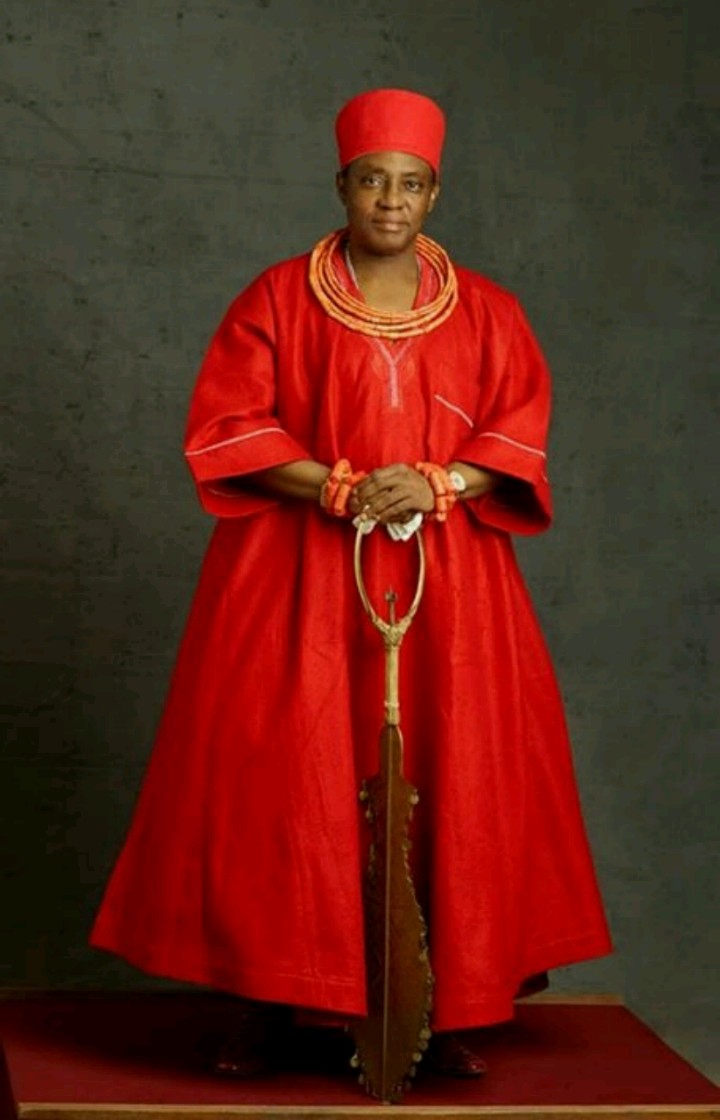
UGI'ODODUA. (UGIE ODODUA)
In old Benin, ugi’ododua was celebrated in the month of the Ẹdo lunar year, which corresponds to mid-March and early April of the Gregorian calendar.
@asemota @EdoSocials @0vienrioba @OyomwanO
#Thread #BeninBronzes #Benin
In old Benin, ugi’ododua was celebrated in the month of the Ẹdo lunar year, which corresponds to mid-March and early April of the Gregorian calendar.
@asemota @EdoSocials @0vienrioba @OyomwanO
#Thread #BeninBronzes #Benin

The ceremony was initially instituted by Ọmọ N’Ọba Ẹweka I in memory of his grandfather Ekaladerhan or Izoduwa. In the 16th century, Ọmọ N’Ọba Ẹsigie, added some rituals, probably Christian fasting rites, to the ceremony, then, in the 18th century,
Ọmọ N’Ọba Eresoyen further modified the festivity by adding other rites. Furthermore, he replaced the original masks worn by the Ododua masquerades, with brass ones modelled after the masks worn by the masquerades of Ọsa N'Uzalla, the deified hero of the people of Uzalla,
a community some 15 kilometres north-east of Benin City in the Ikpoba river valley. In his drive to promote his newly revamped ugi’ododua, Ọmọ N’Ọba Eresoyen banned the performances of Erinmwinọvia, ọvia masquerade, in Benin City.
As a result of the modifications through the centuries, Ugi’ododua is also known as Aguẹ Ọghẹnẹ, Aguẹ Orisa or Awẹ.
Ugi’ododua is a seven-day ceremony. The essential rituals are held in extreme secrecy within the palace in a chamber known as oguan and
Ugi’ododua is a seven-day ceremony. The essential rituals are held in extreme secrecy within the palace in a chamber known as oguan and
restricted to a select group and individuals of the Ogbelaka quarters. Ogbelaka quarters is made up of sixteen guilds (Otu ikennẹsugie). The principal players of the ceremony are Ekhaemwẹn Ọsa and Osuan, the leaders of the Ivbiọsa and Ivbiosuan guilds, respectively.
As the Edo say, Ọsa vbe Osuan ọọ rrẹn emwin nọ rre omẹ, only Ọsa and Osuan know the secret of the unopened palm fronds.
The public rites of the festival are characterised by the special dances of the seven Ẹrinmwinododua, Ododua masquerades.
The public rites of the festival are characterised by the special dances of the seven Ẹrinmwinododua, Ododua masquerades.
The masquerades, in long scarlet attires and their characteristic brass helmets masks, dance seven times forward and backwards before the Benin king-emperor. Each masquerade dances its own particular dance steps and sings its own particular song while reaffirming its loyalty,
and commitment to the protection of the Benin king-emperor. On the seventh and final day, the Benin king-emperor join in the dance. Like all festivals that involve masquerades that are believed to be mystical spirits,
it is forbidden for pregnant women and children to watch the Ododua masquerades performances.
It is quite unfortunate that many of us choose not to read about our arts, culture and history written by Edo people but prefer make-believe stories and
It is quite unfortunate that many of us choose not to read about our arts, culture and history written by Edo people but prefer make-believe stories and
short video clips of the so-called experts, scholars or documenter of African art history and history of Benin/Ile-Ife relationship
The story of Ekaladerhan or Izoduwa (Ododuwa) has been part of Edo folk-tales for nearly 1000 years.
The story of Ekaladerhan or Izoduwa (Ododuwa) has been part of Edo folk-tales for nearly 1000 years.
Ọkhaemwẹn Daniel N. Oronsaye first wrote the story in his book: The History of the Ancient Benin Kingdom and Empire, in the 1950s. Then, in 1960, the Enogie of Ọbazuwa, Enogie Edun Akenzua (then a journalist) published an article
‘A Benin View’, in which he drew attention to the flight of Ekaladerhan to Uhẹ or Ile-Ifẹ. which was published in a Newspaper, the 'Morning Post'. Recently, the Enogie published the detailed story titled, Ekaladerhan.
In 1973, Ọmọ N'Ọba Erediauwa (then prince Solomon Igbinoghodua Akenzua) reiterated the Edo story of Ekaladerhan or Izoduwa (Ododuwa) in a lecture, which he delivered to the Museum Society in Benin City. Again in 1982, during his nationwide ‘Thank You’ tour after his
coronation in 1979, the Ọmọ N'Ọba expressed the Edo viewpoint about Ododuwa and the Benin/Ile-Ife link on the occasion of his visit to Ile-Ifẹ. Actually, on this occasion, it was the Ooni of Ifẹ, Ooni Okunade Sijuwade, Olubuse II who had raised the issue in his
welcome address. Also, in 1984, in a lecture, which he delivered at the Institute of African Studies of the University of Ibadan, Nigeria, Ọmọ N'Ọba Erediauwa, once more stated: ‘We in Benin believe, and there are historical landmarks for such belief, that the person
whom the Yorubas call Ododuwa was the fugitive Prince Ekaladerhan, son of the last Ogiso of Benin by name Ogiso Owodo…’
In 1992, Ena Basimi Ẹwẹka, in his book, The Evolution of Chieftaincy Titles in Benin, repeated the Edo viewpoint and also in 1994 in his book,
In 1992, Ena Basimi Ẹwẹka, in his book, The Evolution of Chieftaincy Titles in Benin, repeated the Edo viewpoint and also in 1994 in his book,
The history of Benin: Ogiso Dynasties 40BC-1200AD Ọkhaemwẹn Osayomwanbọ Osemwingie-Ẹro reiterated.
Finally in 2004, in his autobiography, I Remain Sir Your Obedient Servant, Ọmọ N’Ọba Erediauwa repeated the Edo origin of Ododuwa or Ekaladerhan.
Oba ghato kpere iseeee
Finally in 2004, in his autobiography, I Remain Sir Your Obedient Servant, Ọmọ N’Ọba Erediauwa repeated the Edo origin of Ododuwa or Ekaladerhan.
Oba ghato kpere iseeee
• • •
Missing some Tweet in this thread? You can try to
force a refresh





